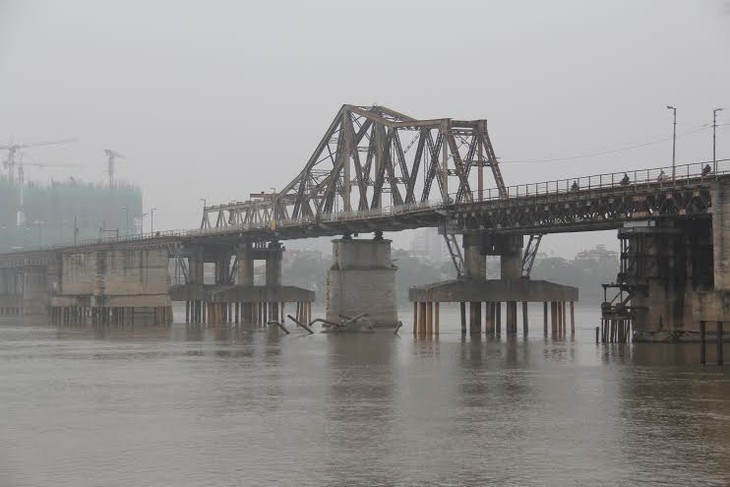(VOVworld) – The Long Bien bridge, formerly known as Paul Doumer bridge was built by the French company Daydé & Pille between 1898 and 1902. It is 1680 m long. In 1902, it was the longest bridge in Indochina. The bridge ahs witnessed a lot of history and is a link to the past. Some fascinating facts about the bridge are contained in documents left by the French.
 |
Today, although cars and trucks are not allowed to cross the bridge, traffic is very dense with trains, pedestrians, bicycles and motorcycles. Many who cross the bridge wonder how it was built. In fact, the year of construction and the names of the creators are still faintly visible on the abutment of the bridge. It was Paul Doumer, Governor General of Indochina at that time who had the original metal structure built. The design of a company called Daydé & Pille was chosen. Built at a cost of 6.2 million francs, Long Bien was the first steel bridge spanning the Red River. Le Huy Tuan works for National Archives Center No 1:"More than anyone the Governor General of Indochina understood the importance of the bridge in facilitating the movement of people and goods between Hanoi, the center of the Red River Delta, and parts of northern Vietnam such as Hai Phong. At that time most goods were transported by boat. The bridge was mainly designed for rail transport but also provided a road on the bridge. Bids were solicited attracting six French contractors and Daydé & Pille was the winner".
The bridge was officially put into operation in 1903, four years after the start of construction. The first train carried King Thanh Thai and the Governor General of Indochina Paul Doumer from Hanoi station to the bridge for an inauguration attended by thousands of Hanoians. The longest bridge in Indochina was dubbed "Paul Doumer bridge." The Governor General of Indochina opened a railway line linking Hanoi to its border with China. The pier on the bank of the Red River closed down. People could use the Long Bien bridge to cross the river even in flood season. The bridge enabled the French to expand their colonial holdings in northern Vietnam. In July 1945, Tran Van Lai, the mayor of Hanoi at that time, renamed the bridge the "Long Bien Bridge", Long Bien being the name of a suburb on the left bank of the Red River. The name has survived. Hanoian Vu Van Thin is very attached to this bridge: "During the war, there was an artillery emplacement on the bridge to shoot enemy’s planes. In 1971, the bridge was flooded. To me, the Long Bien Bridge is the most beautiful and most romantic of all bridges. Its architecture is unique. It is dragon-shaped. Once restored, it will be second to none in the region. "
Initially, the bridge was accessible only to bicycles, trains and pedestrians. 20 years later, two 2-meter wide roads and one 1-meter wide sidewalk were added. Traffic on the bridge was thus defined in a scientific manner. Pedestrians walked on the sidewalk reserved for them. The speed limit was set at 15km per hour. Fires on the bridge were forbidden.
At the time, the newspaper Eveil Economique reported a proposal to build a similar bridge over the Red River. This project was never realized due to the end of French colonization in 1954, but the idea later inspired Hanoi architects. Mr. Tuan said:"This bridge is undoubtedly a symbol of French colonization in Vietnam. But it still enables travel and the transport of goods, so we must preserve this work, which is of great cultural and historical importance. In 1955, the French withdrew from Hanoi to Hai Phong via this bridge. The bridge has been an important witness to history”.
Hanoi now has other bridges over the Red River including Chuong Duong, Thang Long, Thanh Tri, Vinh Tuy and Nhat Tan. But the 2-century old Long Bien bridge is still a favorite walk for Hanoians allowing them to contemplate the Red River in peace and admire the architectural jewel in this history crown.